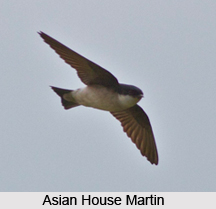 Asian House Martin is an Indian Bird that bears a scientific name "Delichon dasypus". It is a migratory passerine bird of the swallow family Hirundinidae.
Asian House Martin is an Indian Bird that bears a scientific name "Delichon dasypus". It is a migratory passerine bird of the swallow family Hirundinidae.
Structure of Asian House Martin
Asian House Martin has mainly blue-black upperparts, other than its white rump, and has pale grey under parts. Its three subspecies breed in the Himalayan Mountain Range and in central and eastern Asia, and spend the winter lower in the mountains or in Southeast Asia. This species is locally abundant and is expanding northward in Siberia, so there are no concerns about its conservation status.
Breeding of Asian House Martin
Asian House Martin breeds in colonies, building mud nests under an overhang on a vertical cliff or the wall of a building. Both sexes build the nest, incubate the three or four white eggs and feed the chicks.
Feeding of Asian House Martin
Asian House Martin feeds on small insects taken in flight, usually caught high in the air. The presence of terrestrial springtails and Lepidoptera larvae in its diet indicates that food is sometime picked from the ground.
Structure of Asian House Martin
Asian House Martin of the nominate subspecies is 12 cm long, dark steel blue above with a contrasting white rump, grey-washed white under parts, and a slightly forked tail. The tail and upper wings are brownish-black, and the under wings are grey-brown. The legs and feet are brownish-pink and covered with white feathers, the eyes are brown, and the bill is black. There are few differences in appearance between the sexes, although the male is somewhat whiter below than the female, especially in fresh plumage. The juvenile bird is less glossy and has dark brown upperparts, sometimes with a brownish wash to the rump, and grey-white under parts.
Concentration of Asian House Martin
The nominate subspecies of the Asian House Martin, D. D. dasypus, breeds in the southeast of Russia, the Kuril Islands, Japan and sometimes Korea. It migrates through eastern China to winter in the Malay Peninsula, Borneo, the Philippines, Java and Sumatra; a few birds remain around hot springs in Japan. D. d. cashmeriensis breeds in the Himalayas from Afghanistan east to Sikkim and northwards into Tibet and western and central China. It is found between 1,500-5,000 m (4,900-16,400 ft) altitude, although mainly in the 2,400-4,000 m (7,900-13,100 ft) range. This martin is a short-range migrant, mainly wintering at lower altitudes in the foothills of the Himalayas, but with some birds on the plains of north-eastern India, and smaller numbers further a field in Burma and northern Thailand. The third race, D. D. Nigrimentalis, breeds in south-eastern China and southern Siberia. Its wintering grounds are unknown, but birds in Taiwan just move to lower altitudes in winter.
Non Breeder Asian House Martin
Asian House Martin has been recorded as far west as the United Arab Emirates, which are of non breeder. The range of D. D. Cashmeriensis overlaps with that of the Nepal house martin, although they breed at somewhat different altitudes. The height separation and the small differences in appearance seem sufficient to prevent interbreeding.
Habitat of Asian House Martin
The preferred habitat of Asian House Martin is valleys and gorges in mountainous areas or coastal cliffs, where natural caves or crevices provide nest sites. It will also breed on large man-made sites like temples, hotels or power stations.
Movements of Asian House Martin
Asian House Martin tends to move to lower altitude open or hilly country in its wintering areas, although it has been recorded at up to 2,565 m (8,415 ft) in Thailand.
Residence of Asian House Martin
Asian House Martin is a cliff nester, breeding in colonies sited under an overhang on a vertical cliff, usually with the nests not touching. It also frequently nests on large buildings such as temples and bridges, but not to the same extent as the Common House Martin. The nest is a deep mud cone lined with grasses or feathers. Unlike its relatives, the Asian House Martin frequently does not complete the enclosure of its nest, leaving it open instead like a deeper version of a barn swallow nest.



















